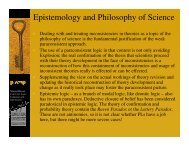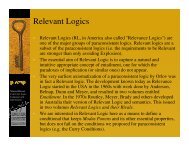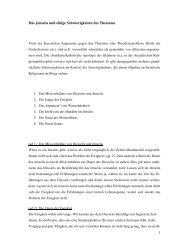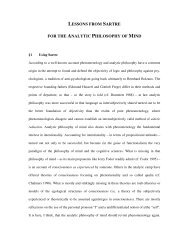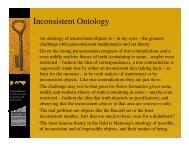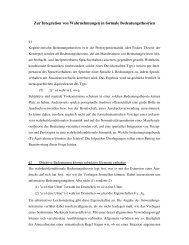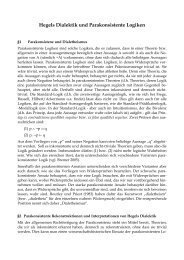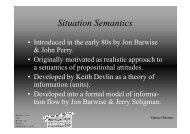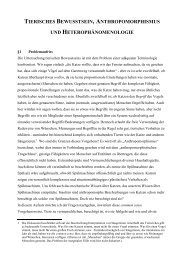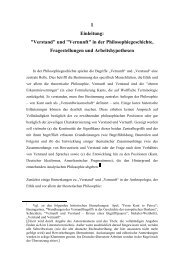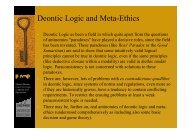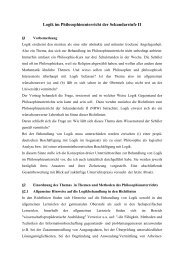What is an Algorithm? - Bremer
What is an Algorithm? - Bremer
What is an Algorithm? - Bremer
You also want an ePaper? Increase the reach of your titles
YUMPU automatically turns print PDFs into web optimized ePapers that Google loves.
<strong>What</strong> <strong>is</strong> <strong>an</strong> <strong>Algorithm</strong>?<br />
A fundamental concept in the theory of computation (<strong>an</strong>d thus in the theory of representations) <strong>is</strong><br />
that of <strong>an</strong> algorithm. Some procedures are said to be ‘algorithmic’, some problems have <strong>an</strong><br />
‘algorithmic’ solution, m<strong>an</strong>y others have not.<br />
Let us approach the definition of <strong>an</strong> algorithm by a route that highlights the need for some<br />
d<strong>is</strong>tinctions the absence of which has caused a lot of confusion about something being<br />
‘algorithmic’ (<strong>an</strong>d especially confusion in claims of refuting the Church-Turing-Thes<strong>is</strong>).<br />
Suppose a TM M1 computes the decimal exp<strong>an</strong>sion of Π. Should we say that Π <strong>is</strong> computable?<br />
1. In a narrow sense Π <strong>is</strong> not computable as we never compute Π (in its entirety). We only<br />
compute Π up to some digit. Computable in the narrow sense <strong>is</strong> the n th digit in the<br />
decimal exp<strong>an</strong>sion of Π. Th<strong>is</strong> computation terminates. One may thus say that Π <strong>is</strong><br />
computable (in principle). [Turing’s classic paper deals with irrationals thus computable!]<br />
2. Th<strong>is</strong> gives us a notion of algorithm in the narrow sense.<br />
An algorithm <strong>is</strong>:<br />
a. Implementation neutral (abstract)<br />
b. Effective in its individual steps (they do not require ingenuity)<br />
c. Finite (given finite input <strong>an</strong>d a finite number of machine states in a finite time the<br />
algorithm terminates with a finite output in finite space if it terminates)<br />
We see implementation neutrality in one algorithm being carried out by devices that may<br />
differ in their architecture <strong>an</strong>d material. If ‘program’ <strong>is</strong> understood as ‘program in one or<br />
the other programming l<strong>an</strong>guage’ then different programming l<strong>an</strong>guages provide different<br />
ways to implement one <strong>an</strong>d the same algorithm.<br />
We see effectiveness in the simple basic steps of the different paradigms of computability<br />
(e.g. moving the head of a Turing Machine or reading a reg<strong>is</strong>ter in a reg<strong>is</strong>ter/abacus<br />
machine). The individual steps are basic mech<strong>an</strong>ical operations.<br />
3. Partial recursive functions are computable in the narrow sense.<br />
[Partial recursive functions correspond to Turing Machines, inter alia.]<br />
4. If one strengthens the finitude constraint to<br />
c’. Finite (given finite input <strong>an</strong>d a finite number of machine states the algorithm<br />
terminates in a finite time with a finite output in finite space)<br />
partial recursive functions are computable in that narrowest sense as well in as much as<br />
there <strong>is</strong> always <strong>an</strong> extensionally equivalent terminating total recursive function.
5. In a broad sense Π may be said to be computable itself as M1 computes it. M1 <strong>is</strong><br />
algorithmic in a broad sense as it <strong>is</strong> <strong>an</strong> infinite sequence of terminating sub-computations.<br />
6. Th<strong>is</strong> gives a notion of <strong>an</strong> algorithm in the broad sense.<br />
An algorithm <strong>is</strong>:<br />
a. Implementation neutral<br />
b. Effective<br />
c. Finite in its sub-computations (each of which given finite input <strong>an</strong>d a finite<br />
number of machine states in a finite time terminates with a finite output in finite<br />
space)<br />
Halting algorithms then are those that enter after finitely m<strong>an</strong>y of such sub-computations<br />
in a halting/accept<strong>an</strong>ce state. Non-halting algorithms either stay in a non-halting state or<br />
cons<strong>is</strong>t of <strong>an</strong> infinite sequence of sub-computations.<br />
7. Allowing for unbounded sub-computations violates the finitude constraint. In th<strong>is</strong> way –<br />
inter alia – the Halting Problem becomes solvable.<br />
8. If some notional computing device <strong>is</strong> (said to be) ‘hyper-computational’ th<strong>is</strong> me<strong>an</strong>s that it<br />
c<strong>an</strong> solve problems not solvable by Turing Machines. Th<strong>is</strong> capacity depends – in the<br />
notional machines proposed so far – on: infinitely m<strong>an</strong>y states, infinite input, infinite<br />
time, space or infinite prec<strong>is</strong>ion of measurements – all features beyond the intuitive<br />
concept of computation <strong>an</strong>d algorithm which involves finitude!<br />
A special case are Oracle Turing Machines, which resort to ineffective steps of<br />
computation (by consulting the oracle). All these notional machines defy realization.<br />
None of them refutes the Church-Turing-Thes<strong>is</strong> or even the Physical Church-Turing-<br />
Thes<strong>is</strong> (that a machine beyond the Turing Limit c<strong>an</strong>not be realized).<br />
M<strong>an</strong>uel <strong>Bremer</strong> 2011/2012



